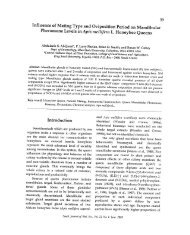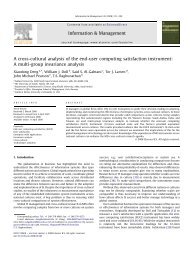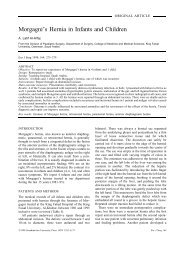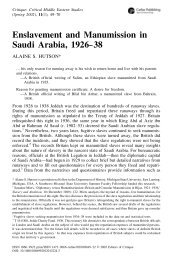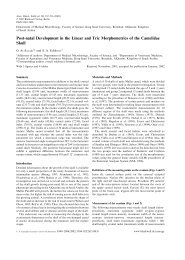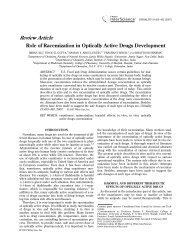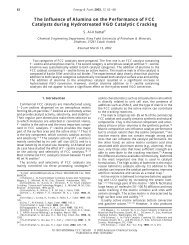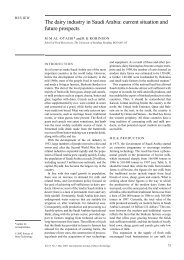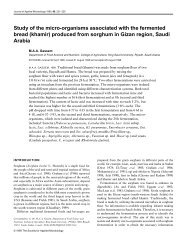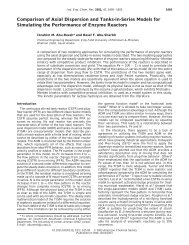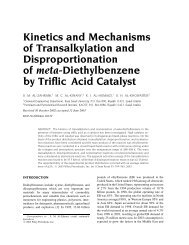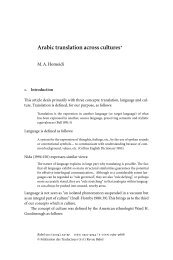Compressibility and swelling characteristics of Al-Khobar ...
Compressibility and swelling characteristics of Al-Khobar ...
Compressibility and swelling characteristics of Al-Khobar ...
Create successful ePaper yourself
Turn your PDF publications into a flip-book with our unique Google optimized e-Paper software.
Abstract<br />
<strong>Compressibility</strong> <strong>and</strong> <strong>swelling</strong> <strong>characteristics</strong> <strong>of</strong> <strong>Al</strong>-<strong>Khobar</strong><br />
Palygorskite, eastern Saudi Arabia<br />
Saad A. Aiban ⁎<br />
Department <strong>of</strong> Civil Engineering, King Fahd University <strong>of</strong> Petroleum <strong>and</strong> Minerals,Dhahran 31261, Saudi Arabia<br />
Received 7 May 2005; received in revised form 25 June 2006; accepted 7 July 2006<br />
Available online 8 September 2006<br />
Expansive soils are found in different locations in eastern Saudi Arabia. The area is arid with high temperatures, highly variable<br />
humidity <strong>and</strong> an excessive rate <strong>of</strong> evaporation compared to the low precipitation. This resulted in the formation <strong>of</strong> water sensitive<br />
soils. In the present investigation, line valve buildings for a sweet water feeder (1118 mm in diameter) were constructed on a highly<br />
expansive material consisting mainly <strong>of</strong> brown palygorskite <strong>and</strong> gray palygorskite with thin sheets <strong>of</strong> gypsum <strong>and</strong> limestone. Block<br />
samples from both palygorskites were brought to the laboratory <strong>and</strong> cores as well as remolded samples were obtained from the<br />
blocks. The two palygorskites were found to be highly plastic <strong>and</strong> have a very high <strong>swelling</strong> potential. The liquid limit (LL) <strong>and</strong><br />
plastic limit (PL) values for the brown palygorskite are 261% <strong>and</strong> 140%, respectively. The gray palygorskite has a LL <strong>of</strong> a 285%<br />
<strong>and</strong> a PL <strong>of</strong> 123%. The oedometer free swell tests for the two palygorskites produced an expansion ranging between 31.8% <strong>and</strong><br />
42.5% for the remolded samples. However, the expansion for cores ranges between 8.3% <strong>and</strong> 19.3%. The constant volume pressure<br />
tests produced a stress in excess <strong>of</strong> 4240 kPa. The swell potential reached a steady state after four days while the <strong>swelling</strong> pressure<br />
reached a steady state in about 3 h. The paper addresses the geology <strong>of</strong> the area, the characterization <strong>of</strong> the geomaterial including<br />
mineralogical composition using X-ray diffraction <strong>and</strong> SEM techniques <strong>and</strong> the <strong>swelling</strong> <strong>characteristics</strong> <strong>of</strong> the material.<br />
© 2006 Elsevier B.V. <strong>Al</strong>l rights reserved.<br />
Keywords: Palygorskite; Expansive material; Arabian shelf; Gypsum; Swell potential; Swelling pressure<br />
1. Introduction<br />
1.1. General<br />
Expansive soils are encountered in many places in the<br />
world. These soils exhibit large expansions when<br />
subjected to an increase in the moisture content.<br />
Construction works in areas where expansive soils<br />
exist can suffer from serious damages regardless <strong>of</strong> the<br />
⁎ Tel.: +966 3 860 2272; fax: +966 3 860 1413.<br />
E-mail address: saiban@kfupm.edu.sa.<br />
Engineering Geology 87 (2006) 205–219<br />
0013-7952/$ - see front matter © 2006 Elsevier B.V. <strong>Al</strong>l rights reserved.<br />
doi:10.1016/j.enggeo.2006.07.003<br />
www.elsevier.com/locate/enggeo<br />
construction type unless the <strong>swelling</strong> <strong>characteristics</strong> are<br />
taken into account. Damage <strong>of</strong> different structures<br />
caused by expansive soils is well documented in the<br />
literature (Chen, 1988). Such soils can cause damages to<br />
reinforced concrete pile caps, grade beams, walkway<br />
slabs, masonry walls, pavements, etc., some <strong>of</strong> which<br />
cannot be easily repaired. It is, therefore, essential to take<br />
into account the behavior <strong>of</strong> these soils during the design,<br />
construction <strong>and</strong> maintenance <strong>of</strong> structures intended for<br />
construction on or within these types <strong>of</strong> expansive soils.<br />
The literature reveals that expansive soils in Saudi<br />
Arabia are found in many locations in the eastern province<br />
<strong>and</strong> northwestern part <strong>of</strong> the Kingdom as reported
206 S.A. Aiban / Engineering Geology 87 (2006) 205–219<br />
by Dhowian (1981), Erol <strong>and</strong> Dhowian (1982), Slater<br />
(1983), Ruwaih (1984), Dhowian et al. (1985), Erol <strong>and</strong><br />
Dhowian (1990), Abduljauwad <strong>and</strong> <strong>Al</strong>-Sulaimani<br />
(1993), Abduljauwad (1994), <strong>and</strong> Azam et al. (2003).<br />
Dhowian et al. (1985) discussed the distribution <strong>and</strong><br />
types <strong>of</strong> expansive soils in Saudi Arabia. They stated that<br />
expansive soils in Saudi Arabia exist in three main types:<br />
(1) shale <strong>of</strong> various degrees <strong>of</strong> weathering, (2)<br />
montmorillonitic clays <strong>and</strong> (3) calcareous clays. They<br />
also stated that Madinah montmorillonite clays <strong>and</strong><br />
Tabuk shales are highly expansive while <strong>Al</strong>-Ghatt <strong>and</strong><br />
Tayma shales <strong>and</strong> H<strong>of</strong>uf calcareous clays have relatively<br />
lower degrees <strong>of</strong> expansion. Table 1 gives a summary <strong>of</strong><br />
the previous work related to expansive soils in Saudi<br />
Arabia.<br />
Abduljauwad (1994) conducted a thorough investigation<br />
on the <strong>swelling</strong> behavior <strong>of</strong> eastern Saudi Arabia<br />
calcareous sediments. He stated that calcareous expansive<br />
clays in eastern Saudi Arabia have moderate to very<br />
high <strong>swelling</strong> potential. A survey <strong>of</strong> damages resulting<br />
from expansive soils in several locations in <strong>Al</strong>-Hassa,<br />
<strong>Al</strong>-Qatif <strong>and</strong> nearby areas has been carried out by<br />
Abduljauwad (1994). The types <strong>of</strong> damage reported<br />
therein included the heaving <strong>of</strong> footpaths, distortion <strong>of</strong><br />
door frames <strong>and</strong> cracking <strong>of</strong> ground floor block work,<br />
reinforced ground beams <strong>and</strong> floor slabs. The problems<br />
encountered due to expansive soils are mainly due to<br />
improper site investigation <strong>and</strong> lack <strong>of</strong> appreciation <strong>of</strong><br />
the <strong>swelling</strong> potential <strong>of</strong> the underlying soils. Though<br />
quantifications <strong>of</strong> damages <strong>of</strong> different structures due to<br />
expansive soils in Saudi Arabia are not fully available,<br />
Ruwaih (1984) stated that building damages due to<br />
differential heave <strong>of</strong> the soil accounts for the greatest<br />
loss as compared with all other damages associated with<br />
construction.<br />
In Saudi Arabia, the <strong>characteristics</strong> <strong>and</strong> formation <strong>of</strong><br />
expansive soils vary significantly from place to place due<br />
to variations in the geology, sedimentation processes <strong>and</strong><br />
climatic conditions. According to Fookes (1978), the<br />
area is characterized by its high temperature, variable<br />
humidity <strong>and</strong> the excessive rate <strong>of</strong> evaporation compared<br />
to the low annual precipitation. Therefore, the <strong>swelling</strong><br />
potential <strong>of</strong> eastern Saudi Arabia is intensified by the arid<br />
climatic conditions <strong>and</strong> severe weathering environment.<br />
In addition, the soils <strong>and</strong> rocks therein are calcareous<br />
in nature, which further enhances the <strong>swelling</strong><br />
<strong>characteristics</strong>.<br />
1.2. Geology <strong>of</strong> the area<br />
<strong>Al</strong>-<strong>Khobar</strong> city is located in the Eastern Province <strong>of</strong><br />
Saudi Arabia on the Arabian Gulf coast as shown in Table 1<br />
Summary <strong>of</strong> the previous work on expansive soils in Saudi Arabia<br />
Umm As<br />
Sahik<br />
Location <strong>Al</strong>-Hassa (including H<strong>of</strong>uf) Madinah <strong>Al</strong>-Ghatt Tabuk Tayma <strong>Al</strong>-Qatif a<br />
Abduljauwad<br />
(1994)<br />
Abduljauwad<br />
(1994)<br />
Ruwaih<br />
(1984)<br />
Dhowian<br />
et al. (1985)<br />
Ruwaih<br />
(1984)<br />
Dhowian<br />
et al. (1985)<br />
Ruwaih<br />
(1984)<br />
Dhowian<br />
et al. (1985)<br />
Ruwaih<br />
(1984)<br />
Dhowian<br />
et al. (1985)<br />
Abduljauwad<br />
(1994) b<br />
Ruwaih<br />
(1984)<br />
Author Dhowian<br />
et al. (1985)<br />
Silty shale Silt Green clay Gray-green<br />
clay<br />
Clayey<br />
shale<br />
Clayey<br />
shale<br />
Clayey<br />
silt<br />
Silty<br />
shale<br />
Clayey<br />
shale<br />
Greenish<br />
clay<br />
Green<br />
clay<br />
White<br />
clay<br />
Red-green<br />
clay<br />
Calcareous<br />
clay<br />
Soil Type Calcareous<br />
clay<br />
LL 60 58 69–142 82 105 69–108 65 46 54–80 61 35–85 38 30–55 71–184 58–140<br />
PL 24 29–47 37 39 30 21 27 25 39–83 26–46<br />
PI 36 33 30–95 45 66 33–56 35 25 21–47 34 22–41 13 12–24 40–127 33–93<br />
SL 18 28 16 21 16 23 20<br />
Swelling (%) 2.54–14.17 0.63–29.49 1.36–12.74<br />
Swell pressure (kPa) 200–1300 14–1930 57–400<br />
a<br />
This includes soils from Umm <strong>Al</strong>-Hammam, <strong>Al</strong>-Jesh <strong>and</strong> <strong>Al</strong>-Ajam.<br />
b<br />
This includes soils from <strong>Al</strong>-Khars, <strong>Al</strong>-Mubarraz, <strong>Al</strong>-Mansoriya, <strong>Al</strong>-Nathel, <strong>Al</strong>-Hamadiya, <strong>Al</strong>-Salehiya <strong>and</strong> Mahasen.
Fig. 1. Geologically, the area is part <strong>of</strong> the Arabian shelf<br />
which was subjected to successive transgression <strong>and</strong><br />
regression cycles <strong>of</strong> the Gulf waters during the<br />
Pleistocene <strong>and</strong> Holocene ages (El-Naggar, 1988). In<br />
general, the surface rocks <strong>of</strong> the region include both<br />
consolidated <strong>and</strong> unconsolidated sediments. The consolidated<br />
sediments belong to Paleocene to middle Eocene<br />
age <strong>and</strong> Miocene to Pliocene age while the unconsolidated<br />
materials contain sediments from Quaternary age<br />
which include shale <strong>and</strong> claystone. The geology <strong>of</strong> the<br />
area has been thoroughly discussed by <strong>Al</strong>-Sayari <strong>and</strong> Zotl<br />
(1978), Powers et al. (1963), <strong>and</strong> others. According to <strong>Al</strong>-<br />
Sayari <strong>and</strong> Zotl (1978), clays are present in different<br />
formations in eastern Saudi Arabia including Rus <strong>and</strong><br />
Dammam formations (Eocene) <strong>and</strong> Hadrukh, Dam <strong>and</strong><br />
H<strong>of</strong>uf formations (Miocene). A brief description <strong>of</strong> the<br />
relevant geological formations is provided in the<br />
following sections (Powers et al., 1963; Johnson, 1978):<br />
a) Rus formation (Tru): this formation is divided into<br />
the following three lithologic units:<br />
1. A 3.6 m thick white s<strong>of</strong>t chalky porous limestone<br />
with calcarenite beds at the top.<br />
2. A 31.8 m thick marl <strong>and</strong> limestone: the material has<br />
irregular masses <strong>of</strong> crystalline gypsum, occasional<br />
thin limestone beds <strong>and</strong> geodal quartz at several<br />
levels. The material is highly variable <strong>and</strong> includes<br />
white compact finely crystalline, anhydrite with<br />
S.A. Aiban / Engineering Geology 87 (2006) 205–219<br />
Fig. 1. Generalized geologic map <strong>of</strong> the Arabian Gulf coastal region <strong>and</strong> its hinterl<strong>and</strong> (Replotted from Johnson, 1978).<br />
207<br />
interbedded green shale <strong>and</strong> minor amounts <strong>of</strong><br />
dolomitic limestone. <strong>Al</strong>ternatively, it may include<br />
gray marl with coarsely crystalline calcite <strong>and</strong><br />
interbedded shale <strong>and</strong> limestone. Such a unit is<br />
highly variable both in lithology <strong>and</strong> thickness.<br />
3. A 21.0 m limestone: the material is gray to buff<br />
compact commonly partially dolomitized limestone<br />
with minor amounts <strong>of</strong> s<strong>of</strong>t limestone made porous<br />
by leaching <strong>of</strong> small organic remains. Quartz<br />
geodes occur rarely in the lower part <strong>and</strong> are typical<br />
<strong>of</strong> the upper part.<br />
b) Dammam formation: this formation is divided into<br />
five members:<br />
1. A 15 m thick <strong>Al</strong>at limestone <strong>and</strong> marl: the upper<br />
part is light colored chalky <strong>and</strong> porous, commonly<br />
dolomitic limestone. It contains abundant molds<br />
<strong>of</strong> mollusks <strong>and</strong> other organic remains. The lower<br />
part is light colored dolomitic marl.<br />
2. A 9.3 m thick <strong>Khobar</strong> limestone <strong>and</strong> marl: the<br />
material is light to dark-brown, in part dolomitic<br />
limestone becoming <strong>of</strong>f-white s<strong>of</strong>t marly limestone.<br />
The lower part consists <strong>of</strong> marl.<br />
3. A 1.0 m thick <strong>Al</strong>veolina limestone: the material<br />
consists <strong>of</strong> yellowish gray, microcrystalline,<br />
partially recrystallized, dolomitized limestone. It<br />
contains common specimens <strong>of</strong> <strong>Al</strong>veolina elliptica<br />
(Sowerby) var. flosculina Silvestri <strong>and</strong> internal<br />
molds <strong>of</strong> Lucina pharaonis.
208 S.A. Aiban / Engineering Geology 87 (2006) 205–219<br />
4. A 4.2 m thick Saila shale: the member consists <strong>of</strong><br />
a 3.6 m dark brownish-yellow subfissile clay shale<br />
underlain by 0.6 m <strong>of</strong> gray-buff limestone.<br />
5. A 3.0 m thick Midra shale: the shale member<br />
consists <strong>of</strong> yellowish-brown, fissile, thinly laminated<br />
shale, gray marl <strong>and</strong> impure limestone. It<br />
contains scattered fossil shark teeth.<br />
c) Hadrukh formation: the thickness <strong>of</strong> this formation<br />
ranges between 20 m <strong>and</strong> 90 m <strong>and</strong> could<br />
reach 120 m in some areas. The formation is<br />
highly variable <strong>and</strong> contains shale, s<strong>and</strong>stone <strong>and</strong><br />
marl in different colors. Inclusions <strong>of</strong> gypsum <strong>and</strong><br />
chert are also present.<br />
d) Dam formation: The thickness <strong>of</strong> this formation<br />
varies considerably from 30 m to 100 m. The<br />
formation consists mainly <strong>of</strong> clay with minor marl<br />
<strong>and</strong> limestone in different colors ranging from<br />
green to red.<br />
e) H<strong>of</strong>uf formation: this formation is 95 m thick <strong>and</strong><br />
consists <strong>of</strong> the following four different members:<br />
(1) gray conglomerate, (2) alternating red <strong>and</strong><br />
white argillaceous s<strong>and</strong>stone, (3) <strong>of</strong>f-white in part<br />
impure s<strong>and</strong>y limestone, <strong>and</strong> (4) red <strong>and</strong> white<br />
conglomerate.<br />
1.3. Palygorskite Material<br />
Palygorskite, which is sometimes known as attapulgite,<br />
consists <strong>of</strong> double silica chains. The minerals in this<br />
group occur in a variety <strong>of</strong> macroscopic forms but are<br />
fibrous or lath-like or fine threadlike on a microscopic<br />
scale. Attapulgite is simply short-fibered palygorskite<br />
<strong>and</strong> some samples <strong>of</strong> these minerals have a fibrous texture<br />
<strong>and</strong> a cardboard or paper-like appearance due to the<br />
tangling <strong>of</strong> fibers (Grim, 1968). The palygorskite crystals<br />
are submicroscopic fibers whose dimensions are quite<br />
variable depending on their origin. The particle diameters<br />
range between 50 <strong>and</strong> 300 Å, while the thickness ranges<br />
between 50 <strong>and</strong> 100 Å <strong>and</strong> the length between 0.2 <strong>and</strong><br />
5 μm (Martin-Vivaldi <strong>and</strong> Robertson, 1971; Mitchell,<br />
1993). The fibers are grouped together in bundles which<br />
are frayed or opened up at the ends (Martin-Vivaldi <strong>and</strong><br />
Robertson, 1971). The structure <strong>of</strong> the fibrous mineral<br />
palygorskite differs from that <strong>of</strong> other layered silicates in<br />
lacking continuous octahedral sheets. The structure <strong>and</strong><br />
morphology <strong>of</strong> the palygorskite crystals are such that a<br />
large number <strong>of</strong> terminal silicate tetrahedra on the ribbons<br />
are present at external surfaces. Broken Si–O–Si bonds<br />
compensate for their residual charge by accepting a<br />
proton or a hydroxyl <strong>and</strong> becoming Si–OH group.<br />
Palygorskite is formed in association with less basic<br />
rocks, e.g. in syenite <strong>and</strong> weathered granite (Newman<br />
<strong>and</strong> Brown, 1987). The presence <strong>of</strong> pyroxene or amphibole<br />
minerals provides a template for the formation <strong>of</strong><br />
palygorskite <strong>and</strong> calcite is also necessary (Henin <strong>and</strong><br />
Caillere, 1975). Palygorskite also occurs in sedimentary<br />
rocks. The industrial mineral resource map <strong>of</strong> Ad Dammam<br />
area clearly indicates the presence <strong>of</strong> Palygorskite<br />
(Roger <strong>and</strong> Prian, 1985). Palygorskite is abundant in the<br />
Arabian sea sediments ranging in age from Pleistocene to<br />
Cretaceous. In the younger sediments the concentration<br />
increases from southeast to northwest, as the Arabian<br />
Peninsula is approached (Weaver, 1989).<br />
Palygorskite is a porous, fibrous clay mineral <strong>and</strong> thus<br />
has a high specific surface that could reach 600 m 2 /g.<br />
Therefore, the material has a high adsorptive capacity.<br />
Besides surface water, palygorskite contains molecular or<br />
zeolitic water within the channels, water coordinated to<br />
the edge octahedral cations <strong>and</strong> the normal hydroxyl<br />
group <strong>of</strong> 2:1 layer silicate at the center <strong>of</strong> the ribbon<br />
(Newman <strong>and</strong> Brown, 1987). The water coordinated to<br />
the octahedral cations is called “bound”, “crystalline” or<br />
“coordinated” water (Newman, 1987). Sorption <strong>of</strong> water<br />
by partially dehydrated palygorskite apparently involves<br />
two processes: (1) sorption on the external surface, which<br />
is rapid, <strong>and</strong> (2) penetration into the channel surfaces,<br />
which is slow <strong>and</strong> only becomes evident when some<br />
zeolitic water is removed. On heating in vacuum, zeolitic<br />
water is lost between 100 <strong>and</strong> 300 °C together with about<br />
half <strong>of</strong> the coordinated water. The loss <strong>of</strong> water causes a<br />
partial collapse or folding <strong>of</strong> the structure (Nagata et al.,<br />
1974; Van Scoyoc et al., 1979); at this stage, the structures<br />
are readily rehydrated if water vapor is readmitted. These<br />
minerals are formed at low temperature <strong>and</strong> pressure<br />
(Henin <strong>and</strong> Caillere, 1975). Wollast et al. (1968) showed<br />
that a sepiolite-like phase was formed in the reaction<br />
between silica <strong>and</strong> seawater at earth surface conditions.<br />
These situations are prevailing in eastern Saudi Arabia<br />
due to the previous transgression <strong>of</strong> the seawater.<br />
In most cases, when palygorskite is present in<br />
bedrock material, it is seen to disappear rapidly during<br />
weathering. This is due to the fact that palygorskite is<br />
known to form from highly concentrated aqueous<br />
solutions. On the other h<strong>and</strong>, palygorskites can be stable<br />
in soils <strong>and</strong> are formed in the weathering environment.<br />
These soils are found in caliches or carbonate precipitating<br />
soils or arid climates. In some pr<strong>of</strong>iles, palygorskite<br />
can comprise 100% <strong>of</strong> the clay size fraction silicate<br />
material (Newman, 1987).<br />
2. Subsurface investigations<br />
The main water tank farm in <strong>Al</strong>-<strong>Khobar</strong> city, eastern<br />
Saudi Arabia, was constructed in a mountainous area to
the west <strong>of</strong> the city. The area is about 25 m above sea<br />
level. A new sweet water feed pipe, 1118 mm (44 in.) in<br />
diameter, has recently been approved for construction to<br />
improve the quality <strong>of</strong> the potable water <strong>and</strong> to meet the<br />
dem<strong>and</strong> on the existing water facility due to the continual<br />
expansion <strong>of</strong> the city. The new pipe runs through a series<br />
<strong>of</strong> line valves housed in rigid concrete structures. The<br />
concrete structures will have bases at about 4.5 m below<br />
the ground surface.<br />
Initially, basic geological <strong>and</strong> geotechnical information<br />
was collected from geological maps, geotechnical<br />
reports <strong>and</strong> relevant publications. Site visits were made<br />
to select locations for the boreholes based on field<br />
observations. The boreholes were drilled using a truckmounted<br />
rig with hollow stem flight auger technique.<br />
The st<strong>and</strong>ard penetration test (SPT) was performed for<br />
every meter, in accordance with the ASTM D 1586<br />
method, <strong>and</strong> the results are all refusal for the entire<br />
drilled depth. The materials extracted using the auger<br />
<strong>and</strong> the SPT sampler show great heterogeneity <strong>of</strong> the<br />
pr<strong>of</strong>ile. Brown palygorskite, gray palygorskite <strong>and</strong><br />
fragments <strong>of</strong> greenish clay <strong>and</strong> crystallized gypsum<br />
<strong>and</strong> other materials are brought to the surface continuously.<br />
The preliminary test results have clearly<br />
indicated that some layers are highly plastic <strong>and</strong> are<br />
expected to have very high swell potential. Such<br />
findings need to be confirmed <strong>and</strong> the swell potential<br />
needs to be quantified in order to consider the necessary<br />
alternatives in the foundation design. This implies the<br />
execution <strong>of</strong> a detailed investigation by exposing the site<br />
through excavation. The site was then excavated using<br />
backhoe to a depth <strong>of</strong> 0.5 m below the desired<br />
foundation level. The excavated area was about 25 m<br />
long, 6 m wide <strong>and</strong> 5 m deep. The heterogeneity <strong>of</strong> the<br />
pr<strong>of</strong>ile is clearly shown in the photographs in Fig. 2. The<br />
S.A. Aiban / Engineering Geology 87 (2006) 205–219<br />
following observations can be made about the exposed<br />
surfaces (Aiban, 2005):<br />
1. The top meter consisted <strong>of</strong> dense, light brown, poorly<br />
graded s<strong>and</strong> mixed with silt <strong>and</strong> gravel.<br />
2. The next layer which extends for variable thickness<br />
consists <strong>of</strong> hard laminated brownish palygorskite.<br />
This layer contains a large number <strong>of</strong> discontinuities/<br />
joints in all directions. Some <strong>of</strong> the joints are filled<br />
with crystallized gypsum. The thickness <strong>of</strong> the<br />
gypsum varies <strong>and</strong> reaches 100 mm in many places,<br />
as shown in Fig. 2. The material is brown with dark<br />
brown <strong>and</strong> orange spots <strong>and</strong> light grey inclusions<br />
which were observed frequently.<br />
3. At the top <strong>of</strong> the brown palygorskite layer, layers <strong>of</strong><br />
light gray to light brown palygorskite were encountered<br />
in few places with variable thicknesses that<br />
could reach 600 mm. The light gray/brownish palygorskite<br />
is less laminated <strong>and</strong> contains fewer discontinuities<br />
compared to the brown palygorskite. The<br />
material was labeled as gray palygorskite. It was<br />
noticed that the brown <strong>and</strong> gray palygorskite layers<br />
are mixed in many places.<br />
3. Laboratory testing <strong>and</strong> results<br />
3.1. Characterization <strong>and</strong> mineralogical composition <strong>of</strong><br />
the material<br />
Representative block samples from both palygorskite<br />
materials were collected <strong>and</strong> brought to the geotechnical<br />
laboratory at King Fahd University <strong>of</strong> Petroleum <strong>and</strong><br />
Minerals (KFUPM). The samples were used for<br />
mineralogical composition, routine characterization<br />
testing <strong>and</strong> oedometer testing using both remolded <strong>and</strong><br />
Fig. 2. Photographs <strong>of</strong> the exposed surfaces showing the fissures <strong>and</strong> the crystallized gypsum.<br />
209
210 S.A. Aiban / Engineering Geology 87 (2006) 205–219<br />
Table 2<br />
Basic geotechnical <strong>and</strong> <strong>swelling</strong> <strong>characteristics</strong> <strong>and</strong> mineralogy <strong>of</strong> the<br />
collected material from <strong>Al</strong>-<strong>Khobar</strong><br />
Parameter Brown material Gray material<br />
Liquid limit (LL) 261% 285%<br />
Plastic limit (PL) 140% 123%<br />
Plasticity index (PI) 121% 162%<br />
Shrinkage limit (SL) 80% 38.5<br />
Natural mc 47% 42%<br />
Mineralogical<br />
composition a<br />
Palygorskite Palygorskite (100)<br />
(100%)<br />
Average swell potential<br />
for remolded samples<br />
at a stress <strong>of</strong> 7 kPa<br />
Average swell potential for<br />
core samples at a stress <strong>of</strong><br />
7 kPa <strong>and</strong> natural mc<br />
Average maximum<br />
<strong>swelling</strong> pressure for<br />
remolded samples at<br />
mc=35%<br />
40% (mc=35%)<br />
34% (mc=47%)<br />
mc = moisture content.<br />
a Obtained using the XRD technique.<br />
8.9% 15.2%<br />
33.5% (mc=35%)<br />
31.8% (mc=42%)<br />
4964 kPa 4344 kPa<br />
core samples. Core samples for oedometer testing were<br />
obtained from the blocks. These cores were identified<br />
<strong>and</strong> wrapped in plastic sheets <strong>and</strong> immersed in molten<br />
wax to prevent moisture loss. Table 2 shows some <strong>of</strong> the<br />
basic geotechnical <strong>characteristics</strong> <strong>and</strong> the mineralogy <strong>of</strong><br />
the two types <strong>of</strong> palygorskite. It is clear from the<br />
plasticity tests that both materials are highly plastic <strong>and</strong><br />
expected to have high swell potential when compared to<br />
the criteria for identifying swell potential, such as the<br />
one proposed by Dakshanamanthy <strong>and</strong> Raman (1973)<br />
Fig. 4. XRD results for the brown <strong>and</strong> the gray palygorskites.<br />
<strong>and</strong> shown in Fig. 3. The data in Fig. 3 clearly shows<br />
that both soils have an extra high swell potential.<br />
Therefore, most <strong>of</strong> the testing program was tailored to<br />
explore the <strong>swelling</strong> <strong>characteristics</strong> <strong>of</strong> the two palygorskites.<br />
The high shrinkage limit for both types <strong>of</strong><br />
palygorskites, especially the brown one, explains the<br />
Fig. 3. Dakshanamanthy <strong>and</strong> Raman criterion for determining the swell potential (Dakshanamanthy <strong>and</strong> Raman, 1973).
fissuring <strong>of</strong> the material upon exposure. The fissures<br />
appeared right after exposure since the natural moisture<br />
content (mc) is less than the shrinkage limit <strong>of</strong> the<br />
material. These fissures produced jointed masses, as<br />
shown in Fig. 2.<br />
In addition to the routine characterization testing, the<br />
X-ray diffraction (XRD) technique, the scanning electron<br />
microscope (SEM) <strong>and</strong> the energy dispersive spectroscopy<br />
(EDS) were used to obtain semi-quantitative mineralogical<br />
composition <strong>and</strong> chemical analysis <strong>of</strong> the material. Typical<br />
XRD results for both materials are shown in Fig. 4. The<br />
data were obtained using a JEOL JDX-3530 X-Ray<br />
Diffractometer (with JEOL JSX-3201 Elemental Analyzer).<br />
Results from the SEM <strong>and</strong> EDS analyses are shown in<br />
Figs. 5 <strong>and</strong> 6 <strong>and</strong> Table 3. These XRD micrographs vividly<br />
S.A. Aiban / Engineering Geology 87 (2006) 205–219<br />
confirm that the material is pure palygorskite. This was<br />
confirmed by repeating the XRD tests using a Siemens<br />
D5005 X-Ray Diffractometer.<br />
Two groups <strong>of</strong> each material were prepared for SEM<br />
testing. In the first group, the samples were prepared to<br />
be perpendicular to the layering or sedimentation <strong>and</strong><br />
these were labeled “cross-section” samples. The second<br />
group was intended to be parallel to the layering or<br />
sedimentation <strong>and</strong> these were labeled “in-plane” samples.<br />
In addition, some samples from each group were<br />
tested at their air-dried mc while some others were tested<br />
after being wetted with distilled water to investigate the<br />
effect <strong>of</strong> wetting on the microstructure. The air-dried<br />
samples were exposed to the laboratory environment for<br />
at least two weeks to ensure a constant mc. The distinct<br />
Fig. 5. SEM micrographs <strong>and</strong> the corresponding energy dispersive spectrum for the brown palygorskite (a <strong>and</strong> b: in-plane, c <strong>and</strong> d: cross-section).<br />
211
212 S.A. Aiban / Engineering Geology 87 (2006) 205–219<br />
Fig. 6. SEM micrographs <strong>and</strong> the corresponding energy dispersive spectrum for the gray palygorskite (a <strong>and</strong> b: in-plane, c <strong>and</strong> d: cross-section).<br />
layering <strong>and</strong> sheet-like or cardboard appearance are clear<br />
in the cross-section samples shown in Figs. 5 <strong>and</strong> 6<br />
Table 3<br />
Chemical analysis for the brown <strong>and</strong> gray material from <strong>Al</strong>-<strong>Khobar</strong><br />
Yellow material Gray material<br />
Element Percent<br />
element<br />
(range)<br />
Atomic<br />
percent<br />
(range)<br />
Percent<br />
element<br />
(range)<br />
Atomic<br />
percent<br />
(range)<br />
O 43.39–48.57 59.50–63.13 41.74–43.00 57.71–59<br />
Mg 4.30–4.69 3.88–4.06 3.92–4.09 3.53–3.94<br />
<strong>Al</strong> 5.87–6.39 4.69–4.96 6.34–7.44 5.19–6.04<br />
Si 31.08–33.38 24.28–24.72 28.40–33.96 22.31–26.74<br />
Cl 1.08–5.38 0.67–3.33 1.76–6.27 1.10–3.9<br />
K 0.82–1.32 0.44–0.74 1.11–1.42 0.63–0.78<br />
Ca 0–0.61 0.03–0.33 1.42–2.49 0.78–1.37<br />
Fe 3.78–10.66 1.41–4.16 6.86–8.70 2.69–3.45<br />
<strong>Al</strong>l values are based on at least three samples from each material.<br />
(plates c <strong>and</strong> d). This is also clear in the in-plane samples<br />
with large magnifications as shown in plate b in Figs. 5<br />
<strong>and</strong> 6.<br />
The effect <strong>of</strong> wetting is clear when comparing the airdried<br />
samples with the wetted ones, as shown in Fig. 7,<br />
whereby the wetted samples (b, d <strong>and</strong> f) exhibited<br />
relatively thick sheets <strong>and</strong> the spacing looks larger<br />
compared to the air-dried samples (a, c <strong>and</strong> e). The<br />
individual layers were more distinct for the wetted<br />
samples compared to the air-dried samples. This clearly<br />
indicates the effect <strong>of</strong> water in the <strong>swelling</strong> process<br />
which causes separation <strong>of</strong> the sheets <strong>and</strong> makes them<br />
thicker because <strong>of</strong> the adsorbed water. It should be<br />
mentioned that the SEM micrographs did not show the<br />
fibrous, lath-like or fine threadlike structure on the<br />
microscopic scale. However, the cardboard or paper-like<br />
appearance was clear in all samples (see Figs. 5, 6 <strong>and</strong> 7).
3.2. Oedometer testing<br />
The effects <strong>of</strong> molding mc <strong>and</strong> sample disturbance on<br />
the one dimensional expansion <strong>and</strong> compression <strong>of</strong> both<br />
types <strong>of</strong> palygorskite were investigated. A series <strong>of</strong><br />
remolded samples <strong>and</strong> cores were prepared from both<br />
materials for one-dimensional oedometer swell/settlement<br />
potential test <strong>of</strong> cohesive soils. Remolded samples<br />
were prepared by grinding the material into powder<br />
passing the ASTM sieve No. 10, i.e. material finer than<br />
2 mm. The remolded samples for the oedometer testing<br />
were prepared at two mc values; one at their respective<br />
field mc <strong>and</strong> the other at a mc <strong>of</strong> 35% for both the brown<br />
<strong>and</strong> gray materials. The field mc was selected to simulate<br />
the field conditions. The 35% was selected in order<br />
to maximize <strong>swelling</strong> <strong>and</strong> was found to be the minimum<br />
molding mc at which the samples from both materials<br />
can be molded easily. The remolded samples were pre-<br />
S.A. Aiban / Engineering Geology 87 (2006) 205–219<br />
Fig. 7. SEM micrographs for wetted <strong>and</strong> air dry samples for the gray palygorskite.<br />
213<br />
pared by mixing the powdered material with the desired<br />
mc <strong>and</strong> the mixture was placed in the oedometer ring<br />
<strong>and</strong> tamped gently <strong>and</strong> uniformly till the desired height<br />
was reached. The number <strong>of</strong> tamps was determined after<br />
many trials in order to st<strong>and</strong>ardize the preparation procedures.<br />
The samples prepared at a mc <strong>of</strong> 35% were<br />
compacted to produce density values that are close to the<br />
in-situ dry density (γ d) (1.06 g/cm 3 for the brown palygorskite<br />
<strong>and</strong> 1.08 g/cm 3 for the gray palygorskite). This<br />
was necessary to compare the two materials at the same<br />
density <strong>and</strong> mc. The γd for the brown palygorskite<br />
prepared at its field mc (47%) was about 1.08 g/cm 3 ,<br />
while γd for the gray palygorskite prepared at its field<br />
mc (42%) raged between 1.0 <strong>and</strong> 1.03 g/cm 3 . These<br />
remolded samples from both materials were prepared to<br />
simulate the field density <strong>and</strong> mc. Two core samples<br />
from each type <strong>of</strong> palygorskite were trimmed from the<br />
blocks to fit properly into the oedometer ring. The
214 S.A. Aiban / Engineering Geology 87 (2006) 205–219<br />
density <strong>of</strong> each core sample was determined. The dry<br />
density values for the two brown cores were 1.09 <strong>and</strong><br />
1.05 g/cm 3 . The two gray cores had dry density values<br />
<strong>of</strong> 0.98 <strong>and</strong> 1.03 g/cm 3 . Two types <strong>of</strong> oedometer tests<br />
were performed: the free swell test <strong>and</strong> the constant<br />
volume test.<br />
3.2.1. Free swell oedometer tests<br />
The one-dimensional oedometer tests are instrumental<br />
in predicting the compressibility, collapse <strong>and</strong><br />
<strong>swelling</strong> potential <strong>of</strong> soils. The free swell test was<br />
performed according to the ASTM D 4546 method. The<br />
test consisted <strong>of</strong> either placing the cores in the<br />
oedometer ring or preparing the remolded samples at<br />
the desired mc in the ring. A seating pressure <strong>of</strong> 7 kPa<br />
was initially applied on the sample. The height reading<br />
after the application <strong>of</strong> the 7 kPa seating stress was<br />
labeled the initial reading (i. e. zero-reading). The<br />
sample was then inundated with distilled water from the<br />
bottom <strong>and</strong> was allowed to swell under the seating<br />
stress. When the <strong>swelling</strong> reading reached a stable value,<br />
which usually takes about four days, one dimensional<br />
loading (compression) <strong>and</strong> unloading were performed.<br />
Most <strong>of</strong> the samples were reloaded after the first cycle <strong>of</strong><br />
loading/unloading.<br />
3.2.1.1. Free swell tests for the brown palygorskite.<br />
For the brown material, three sets <strong>of</strong> samples were tested<br />
to determine the free swell <strong>characteristics</strong> <strong>of</strong> the<br />
material. Each set consisted <strong>of</strong> two identical samples.<br />
Two sets were prepared from the powdered material at<br />
two different mc values (47% <strong>and</strong> 35%) <strong>and</strong> these were<br />
the remolded sets. In the third set, core samples were<br />
tested at the natural mc (47%). The free swell percent<br />
curves are shown in Fig. 8. The results clearly indicate<br />
the high swell potential for the remolded samples. The<br />
maximum swell percent after four days for the remolded<br />
samples prepared at mc values <strong>of</strong> 47% <strong>and</strong> 35% ranges<br />
between 31.8% <strong>and</strong> 41.5% with an average value <strong>of</strong><br />
37%. On the other h<strong>and</strong>, relatively low swell potential<br />
values were recorded for the core samples where the<br />
maximum value for the two samples were 8.3% <strong>and</strong><br />
9.4%. Such a low value is almost one fourth the<br />
corresponding values for the remolded samples at the<br />
same mc values. This could be attributed to the adhesion<br />
in the cores, which developed under pressure <strong>and</strong> was<br />
affected by aging. The adhesion as well as the original<br />
structure are lost upon remolding. Remolding usually<br />
destroys the structure <strong>of</strong> the sample <strong>and</strong> thus the layering<br />
(which usually reflects the sedimentation) is not<br />
retained. The SEM micrographs clearly show the cardboard<br />
or paper-like appearance particle orientation <strong>of</strong><br />
Fig. 8. Free swell curves for the brown palygorskite.<br />
the cores which resulted from the sedimentation process<br />
<strong>and</strong> upon remolding such orientation was lost. The<br />
remolded samples are expected to be more uniform than<br />
the cores in terms <strong>of</strong> density, voids <strong>and</strong> composition. On<br />
the other h<strong>and</strong>, cores are not necessarily homogeneous<br />
<strong>and</strong> some large voids could exist <strong>and</strong> may accommodate<br />
some <strong>swelling</strong>. This will reduce the overall <strong>swelling</strong> <strong>of</strong><br />
the cores.<br />
It is clear from the data presented in Fig. 8 that steady<br />
state for <strong>swelling</strong> was reached after a period <strong>of</strong> about four<br />
days. This is mainly due to the low permeability <strong>of</strong> the<br />
palygorskite <strong>and</strong> thus the penetration <strong>of</strong> water through the<br />
sample was slow. Such time seems reasonable since the<br />
volume increase or <strong>swelling</strong> is proportional to the volume<br />
<strong>of</strong> the wetted sample <strong>and</strong> thus the steady state will be<br />
reached when the entire sample is completely wetted. In<br />
addition, the results show the effect <strong>of</strong> the molding or the<br />
initial mc on the <strong>swelling</strong> potential. The samples prepared<br />
at a mc <strong>of</strong> 35% had <strong>swelling</strong> values higher than those <strong>of</strong><br />
the samples prepared at a mc <strong>of</strong> 47%. The increase in the<br />
swell potential could be as much as 18%, which is<br />
attributed solely to the initial or the molding mc.<br />
The variations in the void ratio (e) with the applied<br />
vertical effective stress (σ′ v) are presented on the e−log<br />
σ′v curves in Figs. 9, 10 <strong>and</strong> 11 for the brown palygorskite.<br />
The data for the remolded samples are similar<br />
<strong>and</strong> the differences between duplicate samples are<br />
minimal. The main difference is the magnitude <strong>of</strong> the<br />
initial <strong>swelling</strong> upon inundation at the seating stress <strong>of</strong><br />
7 kPa. The four remolded samples were prepared to have<br />
the same initial void ratio (e i) <strong>and</strong> thus the e i values<br />
ranged between 1.472 <strong>and</strong> 1.522. The samples prepared<br />
at a mc <strong>of</strong> 35% exhibited larger swell potential compared
Fig. 9. Oedometer test results for the remolded brown palygorskite<br />
prepared at a moisture content <strong>of</strong> 47%.<br />
to the ones prepared at a mc <strong>of</strong> 47%. For the 35% mc<br />
samples, the void ratio changed from ei values <strong>of</strong> 1.522<br />
for the two samples to e f (at the end <strong>of</strong> the free <strong>swelling</strong>)<br />
<strong>of</strong> 2.569 <strong>and</strong> 2.659. The corresponding values for the<br />
47% mc are e i values <strong>of</strong> 1.47 for the two samples <strong>and</strong> the<br />
ef are 2.313 <strong>and</strong> 2.218 at the end <strong>of</strong> the free swell. An<br />
average increase in <strong>swelling</strong> <strong>of</strong> about 17.7% based on the<br />
Fig. 10. Oedometer test results for the remolded brown palygorskite<br />
prepared at a moisture content <strong>of</strong> 35%.<br />
S.A. Aiban / Engineering Geology 87 (2006) 205–219<br />
215<br />
Fig. 11. Oedometer test results for the core brown palygorskite tested<br />
at the natural moisture content (47%).<br />
e values was noticed due to the reduction <strong>of</strong> the initial mc<br />
from 47% to 35%.<br />
3.2.1.2. Compression loading <strong>and</strong> unloading for the<br />
brown palygorskite. In all oedometer tests, once the<br />
free swell readings approached a steady state condition,<br />
at a stress <strong>of</strong> 7 kPa, the samples were then loaded in the<br />
oedometer according to the ASTM D 4546 method.<br />
Upon the one-dimensional loading <strong>and</strong> unloading in the<br />
oedometer, the samples followed a typical soil loading<br />
<strong>and</strong> unloading curve. The loading parts have distinct<br />
virgin portions. The duplicate remolded samples<br />
reached almost the same void ratio (e p) at the maximum<br />
applied stress, which was set at a value <strong>of</strong> 1638 kPa,<br />
regardless <strong>of</strong> the void ratio values at the end <strong>of</strong> the free<br />
swell (ef). The (ep) values for the 35% mc samples were<br />
1.788 <strong>and</strong> 1.809, while the corresponding values for the<br />
47% mc were 1.678 <strong>and</strong> 1.670. The duplicate remolded<br />
samples exhibited consistent loading/unloading behavior<br />
as shown in Figs. 9 <strong>and</strong> 10.<br />
The cores displayed similar behavior to the remolded<br />
samples <strong>and</strong> the loading <strong>and</strong> unloading curves are<br />
similar to those <strong>of</strong> regular soils. The two core samples<br />
that were selected to be similar show large variations in<br />
the magnitude <strong>of</strong> the e values after wetting (ef) <strong>and</strong> after<br />
loading to a stress <strong>of</strong> 1638 kPa (ep). This clearly indicates<br />
that core samples cannot necessarily be assumed<br />
identical. For the two cores, the e i values were 1.459 <strong>and</strong><br />
1.529. The corresponding e f values at the end <strong>of</strong> the free<br />
swell were 1.681 <strong>and</strong> 1.799. The ep values at the
216 S.A. Aiban / Engineering Geology 87 (2006) 205–219<br />
maximum stress value (1638 kPa) were 1.519 <strong>and</strong><br />
1.627. Upon unloading to a stress <strong>of</strong> 7 kPa, the samples<br />
rebound <strong>and</strong> the resulting unloading void ratio (e u)<br />
values are somewhat high, especially for the cores. The<br />
eu for the cores were 1.777 <strong>and</strong> 1.667 while the corresponding<br />
ef values were 1.799 <strong>and</strong> 1.681. This shows<br />
that wetting <strong>and</strong> loading the core samples did not change<br />
the swell potential significantly. On the other h<strong>and</strong>, the<br />
e u values for the remolded brown samples were 2.238<br />
<strong>and</strong> 2.32 while the corresponding e f values were 2.659<br />
<strong>and</strong> 2.569. Such data indicate that wetting <strong>and</strong> loading<br />
<strong>of</strong> remolded samples reduce the swell potential although<br />
remolding had already increased the swell potential<br />
significantly.<br />
3.2.1.3. Free swell tests for the gray palygorskite.<br />
Similar to the brown palygorskite, three sets <strong>of</strong> samples<br />
from the gray material were tested for the free swell<br />
determination. Two sets were prepared from the<br />
powdered material; one at the natural mc (42%) while<br />
the other was at a mc <strong>of</strong> 35%. The third set consisted <strong>of</strong><br />
cores. The free swell curves are presented in Fig. 12.<br />
The data presented are similar to those for the brown<br />
material but the magnitude <strong>of</strong> <strong>swelling</strong> <strong>of</strong> the remolded<br />
material was less for the gray samples. The average<br />
maximum swell percentage for remolded sample prepared<br />
at mc values <strong>of</strong> 42% <strong>and</strong> 35% were 31.9% <strong>and</strong><br />
33.6%, respectively.<br />
The variations <strong>of</strong> the void ratio (e) with the applied<br />
vertical effective stress σv′ are presented on the e−log σv′<br />
curves in Figs. 13, 14 <strong>and</strong> 15 for the gray palygorskite.<br />
The samples prepared at a mc <strong>of</strong> 35% exhibited larger<br />
Fig. 12. Free swell curves for the gray palygorskite.<br />
Fig. 13. Oedometer test results for the remolded gray palygorskite<br />
prepared at a moisture content <strong>of</strong> 42%.<br />
swell potential compared to the ones prepared at a mc <strong>of</strong><br />
42%. For the 42% mc samples, the void ratio changed<br />
from e i values <strong>of</strong> 1.666 <strong>and</strong> 1.59 for the two samples to e f<br />
<strong>of</strong> 2.462 <strong>and</strong> 2.364 at the end <strong>of</strong> the free swell. The<br />
corresponding values for the 35% mc are ei values <strong>of</strong><br />
1.48 for the two samples <strong>and</strong> the ef are 2.313 <strong>and</strong> 2.311 at<br />
Fig. 14. Oedometer test results for the remolded gray palygorskite<br />
prepared at a moisture content <strong>of</strong> 35% (only one sample is shown since<br />
the curves for the second one are exactly overlaying the first one).
Fig. 15. Oedometer test results for the core gray palygorskite tested at<br />
the natural moisture content (42%).<br />
the end <strong>of</strong> the free swell. An average increase in <strong>swelling</strong><br />
upon inundation <strong>of</strong> about 8% based on the e values was<br />
noticed due to the reduction <strong>of</strong> mc from 42% to 35%. The<br />
curves in Fig. 12 clearly show that duplicate gray samples<br />
<strong>of</strong> each remolded set give almost the same swell potential<br />
curves.<br />
On the other h<strong>and</strong>, the gray core samples showed<br />
swell potential values higher than those for the brown<br />
material <strong>and</strong> this is attributed to the type <strong>of</strong> material <strong>and</strong><br />
the mc. The brown palygorskite cores were tested at a<br />
moisture content <strong>of</strong> 47% while the gray palygorskite<br />
cores were tested a moisture content <strong>of</strong> 42%. This could<br />
explain why the gray palygorskite produced high swell<br />
potential (11.2% <strong>and</strong> 19.2%) compared to the brown<br />
palygorskite (8.3% <strong>and</strong> 9.4%). It is also noted that the<br />
two gray core samples exhibited large variations in the<br />
swell potential readings where one has a steady state<br />
value <strong>of</strong> about 11.2% while the other has a value <strong>of</strong><br />
about 19.2%. These deviations are expected for naturally<br />
occurring material in which the density, composition<br />
<strong>and</strong> moisture content cannot be assumed identical.<br />
The curves presented in Figs. 8 <strong>and</strong> 12 shows that the<br />
remolded brown palygorskite prepared at a mc <strong>of</strong> 35%<br />
show higher <strong>swelling</strong> potential (38.9% <strong>and</strong> 42.5%)<br />
compared to the gray palygorskite prepared at the same<br />
mc <strong>and</strong> produced a <strong>swelling</strong> <strong>of</strong> 33.6% for both samples.<br />
This is attributed to the differences in the <strong>characteristics</strong><br />
<strong>of</strong> the two palygorskites; for example the shrinkage limit<br />
S.A. Aiban / Engineering Geology 87 (2006) 205–219<br />
for the brown palygorskite is 80% while that <strong>of</strong> the gray<br />
palygorskite is 38.5%.<br />
3.2.1.4. Compression loading <strong>and</strong> unloading for the<br />
gray palygorskite. The gray palygorskite was loaded<br />
in the oedometer after reaching the steady state <strong>swelling</strong><br />
at a stress <strong>of</strong> 7 kPa, in a way similar to that for the brown<br />
palygorskite. Figs. 13 <strong>and</strong> 14 show that the samples<br />
follow a typical soil loading <strong>and</strong> unloading curve. The<br />
loading parts have distinct virgin portions. The duplicate<br />
remolded samples reached almost the same void ratio<br />
(ep) at the maximum applied stress <strong>of</strong> 1638 kPa, regardless<br />
<strong>of</strong> the ef values at the end <strong>of</strong> the free swell. The ep<br />
values at the 1638 kPa stress for the 35% mc samples<br />
were 1.684 <strong>and</strong> 1.670, while the corresponding values<br />
for the 42% mc were 1.727 <strong>and</strong> 1.751.<br />
The cores displayed similar behavior to the remolded<br />
samples <strong>and</strong> the loading <strong>and</strong> unloading curves were<br />
similar to those <strong>of</strong> regular soils. The two core samples<br />
that were selected to be similar show large variations in<br />
the magnitude <strong>of</strong> the e values after wetting <strong>and</strong> after<br />
loading to a stress <strong>of</strong> 1638 kPa. This is expected since the<br />
two core samples are not necessary identical. For the two<br />
core samples, the ei values were 1.570 <strong>and</strong> 1.731. The<br />
corresponding e f values at the end <strong>of</strong> the free swell were<br />
1.861 <strong>and</strong> 2.346. The e p values at the maximum stress<br />
value (1638 kPa) were 1.665 <strong>and</strong> 1.882.<br />
Upon unloading to a stress <strong>of</strong> 7 kPa, the samples<br />
behaved in a way similar to that <strong>of</strong> the brown palygorskite.<br />
The core samples rebound to almost their ef values i.e. the<br />
eu for the cores were 1.832 <strong>and</strong> 2.289 while the corresponding<br />
ef values were 1.861 <strong>and</strong> 2.346. However, the<br />
e u values for the remolded samples (35% mc) were 2.056<br />
<strong>and</strong> 2.103 while the corresponding e f values were 2.311<br />
for both samples. This confirms the observations made for<br />
the brown palygorskite regarding the effect <strong>of</strong> remolding,<br />
wetting, loading <strong>and</strong> unloading. Careful inspection <strong>of</strong> the<br />
curves presented in Figs. 11 <strong>and</strong> 15, for the core samples,<br />
clearly show that unloading takes the samples very close<br />
to their initial void ratios. This indicates that prewetting<br />
<strong>and</strong> loading does not reduce the swell potential since upon<br />
unloading the sample rebound to its void ratio after the<br />
initial prewetting.<br />
3.3. Constant volume oedometer tests<br />
217<br />
The constant volume oedometer tests are instrumental<br />
in predicting the <strong>swelling</strong> pressure <strong>of</strong> expansive soils.<br />
Constant volume tests were conducted by placing the<br />
samples in the oedometer <strong>and</strong> applying a seating load <strong>of</strong><br />
7 kPa <strong>and</strong> then restraining the vertical movement by a<br />
rigid reaction frame. The rigid frame reacts against the
218 S.A. Aiban / Engineering Geology 87 (2006) 205–219<br />
Fig. 16. Swelling pressure curves for the remolded brown <strong>and</strong> gray<br />
palygorskites prepared at a moisture content <strong>of</strong> 35%.<br />
sample through a high capacity load cell. Upon inundation,<br />
the material tries to exp<strong>and</strong> but the restraining<br />
effect from the rigid frame results in a pressure build up,<br />
which is measured using a high capacity load cell. The<br />
stress-time curves for the remolded samples are shown<br />
in Fig. 16, for both the brown <strong>and</strong> the gray palygorskites.<br />
The average maximum stress for the brown <strong>and</strong><br />
gray palygorskites are 4989 kPa <strong>and</strong> 4361 kPa, respectively.<br />
The data show that high stresses were developed<br />
upon samples inundation. The maximum stress<br />
was reached in about 3 h which is relatively short<br />
compared to the four days needed to reach maximum<br />
swell potential. This is expected since the volume increase<br />
is dependent on the volume <strong>of</strong> the specimen or<br />
the thickness <strong>of</strong> the specimen that got wetted. Therefore,<br />
each part that got wetted will produce a <strong>swelling</strong> or<br />
expansion proportional to the height <strong>of</strong> the wetted<br />
portion. This <strong>swelling</strong> will accumulate at the surface <strong>of</strong><br />
the specimen <strong>and</strong> will be recorded as a total height<br />
increase. On the other h<strong>and</strong>, the force resulting from<br />
<strong>swelling</strong> is related to the area <strong>and</strong> not to the thickness <strong>of</strong><br />
the specimen. The specimen has a constant area <strong>and</strong> a<br />
certain amount <strong>of</strong> stress will result when the surface is<br />
wetted regardless <strong>of</strong> the wetted thickness. Thus, the time<br />
required to wet the top or bottom few millimeters will be<br />
much shorter than the time required to wet the entire<br />
sample thickness even if it is only 19 mm thick. Hence,<br />
stress develops as soon as the surfaces (top <strong>and</strong>/or<br />
bottom) get wetted <strong>and</strong> this is what triggers severe<br />
damages in rigid structures. Similar data has been<br />
reported by Chen (1988) who showed that the stress for<br />
end bearing piles reached a constant value in less than<br />
two days; while expansion for the end bearing piles<br />
under the same conditions took more than seven days to<br />
reach a constant value. It is, therefore, important to<br />
realize that for <strong>swelling</strong> stress to develop, it is not<br />
necessary to wet the entire layer. Furthermore, the<br />
curves in Fig. 16 show that the pressure reaches its<br />
maximum in about 3 h, after which the pressure decreased.<br />
The decrease in pressure was very small, however,<br />
it indicates that when more specimens' height got<br />
wetted the sample got s<strong>of</strong>ter <strong>and</strong> the stress did not keep<br />
increasing but instead it decreased.<br />
4. Summary <strong>and</strong> conclusions<br />
This investigation was carried out to determine the<br />
mineralogical composition <strong>and</strong> assess the <strong>swelling</strong> potential<br />
<strong>of</strong> <strong>Al</strong>-<strong>Khobar</strong> palygorskite. Based on the results<br />
reported in this study, the following concluding remarks<br />
can be made:<br />
1. The two <strong>Al</strong>-<strong>Khobar</strong> palygorskite soils have very high<br />
Atterberg limits <strong>and</strong> very high <strong>swelling</strong> pressure <strong>and</strong><br />
swell potential.<br />
2. The XRD data show that the samples are pure<br />
palygorskite.<br />
3. The undisturbed samples (cores) exhibited <strong>swelling</strong><br />
potential values that were much less than the corresponding<br />
values for the remolded samples. This<br />
could be ascribed to the changes <strong>of</strong> sample structure<br />
due to remolding.<br />
4. The maximum <strong>swelling</strong> pressure for the two palygorskites<br />
was developed in a much shorter time (3 h)<br />
compared to the maximum swell potential which<br />
took more than four days.<br />
5. Prewetting did not reduce the swell potential for core<br />
samples.<br />
6. Remolding increased the swell potential significantly;<br />
however, recompaction <strong>and</strong> wetting reduced the<br />
swell potential after one cycle <strong>of</strong> loading <strong>and</strong> unloading<br />
in the oedometer.<br />
Acknowledgement<br />
The author acknowledges the support provided by<br />
King Fahd University <strong>of</strong> Petroleum <strong>and</strong> Minerals.<br />
Thanks are extended to late Hassan Zakariya Saleh,<br />
Engineer Arifulla Vantilla <strong>and</strong> Engineer Walid El-Mehdi<br />
for their help in the experimental work. The cooperation<br />
<strong>of</strong> the Saline Water Conversion Corporation (SWCC),<br />
<strong>Al</strong>-<strong>Khobar</strong> Branch <strong>and</strong> Tekfen Construction <strong>and</strong><br />
Installation Company during the field work is dutifully<br />
acknowledged.
References<br />
Abduljauwad, S.N., 1994. Swelling behavior <strong>of</strong> calcareous clay from<br />
the eastern province <strong>of</strong> Saudi Arabia. Quarterly Journal <strong>of</strong><br />
Engineering Geology 27, 333–351.<br />
Abduljauwad, S.N., <strong>Al</strong>-Sulaimani, G.J., 1993. Determination <strong>of</strong> swell<br />
potential <strong>of</strong> <strong>Al</strong>-Qatif clay. Geotechnical Testing Journal, ASTM 16<br />
(4), 469–484.<br />
Aiban, S.A., 2005. Swelling <strong>characteristics</strong> <strong>of</strong> <strong>Al</strong>-<strong>Khobar</strong> marl, eastern<br />
Saudi Arabia. Proceedings <strong>of</strong> International Conference on<br />
Problematic Soils, vol. 2. Eastern Mediterranean University,<br />
Famagusta, N. Cyprus, pp. 613–620. 25-27 May.<br />
<strong>Al</strong>-Sayari, S.J., Zotl, J.G. (Eds.), 1978. Quaternary Period in Saudi<br />
Arabia, vol. 1. Springer-Verlag, Wien, Austria.<br />
Azam, S., Abduljauwad, S.N., <strong>Al</strong>-Amoudi, O.S.B., 2003. Volume change<br />
<strong>of</strong> arid calcareous soils. Natural Hazards Review, ASCE 4 (2), 90–94.<br />
Chen, F.H., 1988. Foundation on Expansive Soils. Elsevier Scientific<br />
Publishing Co, Amsterdam.<br />
Dakshanamanthy, V., Raman, V., 1973. A simple method <strong>of</strong> identifying<br />
an expansive soil. Soils <strong>and</strong> Foundations, Japanese Society <strong>of</strong> Soil<br />
Mechanics <strong>and</strong> Foundation Engineering 13 (1), 97–104 (March).<br />
Dhowian, A.W., 1981. Characteristics <strong>of</strong> <strong>Al</strong>-Ghatt collapsing <strong>and</strong><br />
<strong>swelling</strong> soils. Symposium on Geotechnical Problems in Saudi<br />
Arabia, Riyadh 1, 3–32.<br />
Dhowian, A., Ruwaih, I., Erol, A., Youssef, A., 1985. The distribution<br />
<strong>and</strong> evaluation <strong>of</strong> the expansive soils in Saudi Arabia. Proceedings<br />
<strong>of</strong> the Second Saudi Engineering Conference, Dhahran, Saudi<br />
Arabia, vol 4, pp. 1969–1990.<br />
El-Naggar, Z., 1988. Foundation problems in sabkha deposits. Short<br />
Course on Foundation Engineering for Practicing Engineers, CE<br />
Department, KFUPM, pp. SD1–SD54.<br />
Erol, A.O., Dhowian, A.W., 1982. Swell <strong>and</strong> shrinkage behavior <strong>of</strong><br />
Madinah active clays. Journal <strong>of</strong> Engineering Sciences, King Saud<br />
University 8 (2), 78–84.<br />
Erol, A.O., Dhowian, A.W., 1990. Swell behavior <strong>of</strong> arid climate shales<br />
from Saudi Arabia. Quarterly Journal <strong>of</strong> Engineering Geology 33,<br />
243–254.<br />
Fookes, P.G., 1978. Middle East — inherent ground problems.<br />
Quarterly Journal <strong>of</strong> Engineering Geology II, 33–49.<br />
Grim, R.E., 1968. Clay Mineralogy. McGraw-Hill, New York.<br />
S.A. Aiban / Engineering Geology 87 (2006) 205–219<br />
219<br />
Henin, S., Caillere, S., 1975. Fibrous minerals. In: Gieseking, J.E.<br />
(Ed.), Ch. 9 in Soil Components. Inorganic Components, vol. 2.<br />
Springer–Verlag, Berlin, pp. 335–349.<br />
Johnson, D.H., 1978. Gulf coastal region <strong>and</strong> 1st Hinterl<strong>and</strong>: general<br />
geology. In: <strong>Al</strong>-Sayari, Zotl (Eds.), Quaternary Period in Saudi<br />
Arabia. Springer–Verlag, Wien, Austria, pp. 45–50.<br />
Martin-Vivaldi, J.L., Robertson, R.H.S., 1971. Palygorskite <strong>and</strong> sepiolite<br />
(the hormites). In: Gard, J.A. (Ed.), Electron-optical investigation <strong>of</strong><br />
clays. Mineralogical Society, London, pp. 255–276.<br />
Mitchell, J.K., 1993. Fundamental <strong>of</strong> Soil Behavior. John Wiley &<br />
Sons Inc, New York.<br />
Nagata, H., Shimoda, S., Sudo, T., 1974. On dehydration <strong>of</strong> bound<br />
water <strong>of</strong> sepiolite. Clays Clay Minerals 22, 285–293.<br />
Newman, A.C.D., 1987. The interaction <strong>of</strong> water with clay mineral<br />
surfaces. In: Newman, A.C.D. (Ed.), Chemistry <strong>of</strong> Clays <strong>and</strong> Clay<br />
Mineral. Mineralogical Society Monograph, vol. 6. Longman<br />
Scientific <strong>and</strong> Technical, Engl<strong>and</strong>.<br />
Newman, A.C.D., Brown, G., 1987. The chemical constituents <strong>of</strong><br />
clays. In: Newman, A.C.D. (Ed.), Chemistry <strong>of</strong> Clays <strong>and</strong> Clay<br />
Mineral. Mineralogical Society Monograph, vol. 6. Longman<br />
Scientific <strong>and</strong> Technical, Engl<strong>and</strong>.<br />
Powers, L.F., Ramirez, L.F., Redmond, C.D., Elberg, E.L., 1963.<br />
Geology <strong>of</strong> the Arabian Peninsula — sedimentary geology <strong>of</strong><br />
Saudi Arabia. ARAMCO-USGS (147 pp.).<br />
Roger, J., Prian, J.P., 1985. Industrial Mineral Resources Map <strong>of</strong> Ad<br />
Dammam, Kingdom <strong>of</strong> Saudi Arabia. Ministry <strong>of</strong> Petroleum <strong>and</strong><br />
Mineral Resources, Kingdom <strong>of</strong> Saudi Arabia.<br />
Ruwaih, A.I., 1984. Case studies on <strong>swelling</strong> soils in Saudi Arabia.<br />
Proceedings <strong>of</strong> the 5th International Conference on Expansive<br />
Soils, Adelaide, South Australia, May 1984, pp. 348–353.<br />
Slater, D.E., 1983. Potential expansive soils in Arabian Peninsula.<br />
Journal <strong>of</strong> Geotechnical Engineering, ASCE 109 (5), 744–746.<br />
Weaver, C.E., 1989. Clays, muds, <strong>and</strong> shales. Development in Sedimentology,<br />
vol. 44. Elsevier Scientific Publishing Co, Amsterdam.<br />
Wollast, R., Mackenzie, F.T., Bricker, O.P., 1968. Experimental<br />
precipitation <strong>and</strong> genesis <strong>of</strong> sepiolite at earth surface conditions.<br />
American Mineralogist 53, 1645–1662.<br />
Van Scoyoc, G.E., Serna, C.J., Ahlrichs, J.L., 1979. Structural changes<br />
in palygorskite during dehydration <strong>and</strong> dehydroxylation. American<br />
Mineralogist 64, 215–223.



